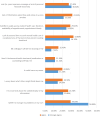Prevalence of depressive, anxiety, and stress symptoms and barriers to mental health services among medical students at Jazan University, Saudi Arabia: A cross-sectional study
- PMID: 40184119
- PMCID: PMC11709213
- DOI: 10.1097/MD.0000000000041185
Prevalence of depressive, anxiety, and stress symptoms and barriers to mental health services among medical students at Jazan University, Saudi Arabia: A cross-sectional study
Abstract
Medical students represent the future of the healthcare workforce. However, the demanding nature of medical education places them at an increased risk of mental health issues. Ensuring their mental well-being is crucial for maintaining a competent and compassionate healthcare system. This study aims to determine the prevalence of depression, anxiety, and stress, along with barriers to accessing mental health services among medical students. A cross-sectional self-administered online survey conducted among medical students of Jazan University, Saudi Arabia, from September 2023 to March 2024. Descriptive and inferential statistical analyses were conducted using International Business Machines Corporation Statistical Package for the Social Sciences version 27.0.1 (Chicago). The study included 390 participants. Median scores for depression, anxiety, and stress were 14.00, 12.00, and 16.00, respectively, with interquartile ranges of 4.00 to 22.00, 4.00 to 20.00, and 6.00 to 24.00. Depression severity categories showed that 38.2% were normal, while 11.5%, 31.8%, 13.6%, and 4.9% experienced mild, moderate, severe, and extremely severe symptoms, respectively. Anxiety severity classifications revealed 37.4% as normal, with 6.2%, 17.4%, 10.0%, and 29.0% falling into mild, moderate, severe, and extremely severe categories, respectively. For stress, 49.2% were normal, while 11.0%, 16.7%, 14.1%, and 9.0% experienced mild, moderate, severe, and extremely severe levels, respectively. Barriers to accessing mental health care included a preference for self-management, confidentiality concerns, societal judgment, and fears of career-related repercussions. This study highlights a high prevalence of depression, anxiety, and stress among medical students at Jazan University, with notable gender differences and symptom severity. Addressing barriers to mental health care, such as confidentiality concerns and societal stigma, is essential to improving service utilization and student well-being.
Copyright © 2025 the Author(s). Published by Wolters Kluwer Health, Inc.
Conflict of interest statement
The authors have no conflicts of interest to disclose.
Figures
Similar articles
-
Effect of Stress on Sleep Quality among Medical Students: A Cross-sectional Study at Jazan University, Saudi Arabia.Ann Afr Med. 2024 Oct 1;23(4):586-593. doi: 10.4103/aam.aam_7_24. Epub 2024 Aug 13. Ann Afr Med. 2024. PMID: 39138930 Free PMC article.
-
Barriers to mental health service utilisation among medical students in Saudi Arabia.Front Public Health. 2024 Apr 12;12:1371628. doi: 10.3389/fpubh.2024.1371628. eCollection 2024. Front Public Health. 2024. PMID: 38680929 Free PMC article.
-
Prevalence of depression, anxiety, and stress among students enrolled at King Khalid University: a cross-sectional study.BMC Public Health. 2025 Jan 28;25(1):354. doi: 10.1186/s12889-025-21277-7. BMC Public Health. 2025. PMID: 39875847 Free PMC article.
-
Depression, anxiety and stress among medical and non-medical students in Saudi Arabia: An epidemiological comparative cross-sectional study.Neurosciences (Riyadh). 2021 Apr;26(2):141-151. doi: 10.17712/nsj.2021.2.20200127. Neurosciences (Riyadh). 2021. PMID: 33814366 Free PMC article.
-
Prevalence and correlates of imposter syndrome and self-esteem among medical students at Jazan University, Saudi Arabia: A cross-sectional study.PLoS One. 2024 May 9;19(5):e0303445. doi: 10.1371/journal.pone.0303445. eCollection 2024. PLoS One. 2024. PMID: 38723002 Free PMC article.
References
-
- World Health Organization. Mental, behavioural or neurodevelopmental disorders. International classification of diseases for mortality and morbidity statistics. 2019.
-
- Dyrbye LN, Thomas MR, Shanafelt TD. Systematic review of depression, anxiety, and other indicators of psychological distress among US and Canadian medical students. Acad Med. 2006;81:354–73. - PubMed
-
- Tjia J, Givens JL, Shea JA. Factors associated with undertreatment of medical student depression. J Am College Health. 2005;53:219–24. - PubMed
MeSH terms
LinkOut - more resources
Full Text Sources
Medical



